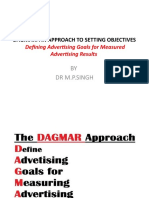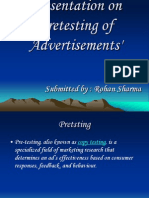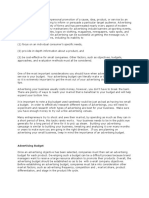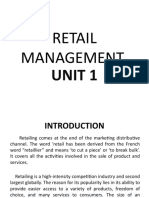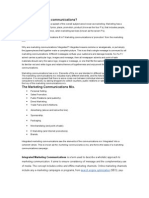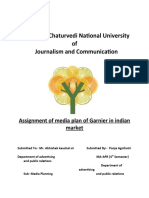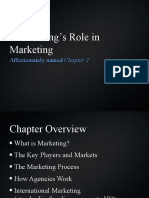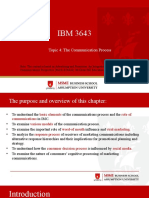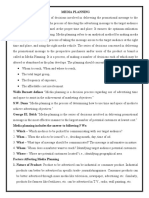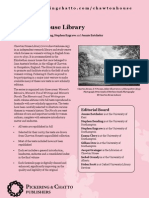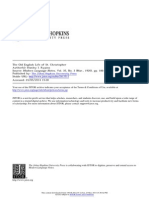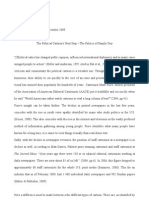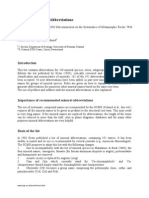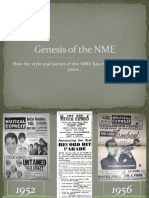The Media Mix
The Media Mix
Uploaded by
Mona SriCopyright:
Available Formats
The Media Mix
The Media Mix
Uploaded by
Mona SriCopyright
Available Formats
Share this document
Did you find this document useful?
Is this content inappropriate?
Copyright:
Available Formats
The Media Mix
The Media Mix
Uploaded by
Mona SriCopyright:
Available Formats
The Media Mix The Media Mix Media mix means the advertising strategy encompasses the use
of more than one type of advertising media to get its message across the target audience. A combination of media types is known as the media mix. No advertiser can rely only on one medium to reach his audience. Even a small advertiser having a small media budget has thousands of media from which to choose. A typical media mix for consumer products, such as a soft drink, will include television, outdoor, POP and even the print media. this combination plays a crucial role in reaching the maximum number of consumers at the minimum cost. Once a media plan is ready, the decision is to be made about the media mix. Selecting the media mix involves several considerations. Media mix of all major kinds, including broadcast (national, local) TV, cable TV, radio, print (newspapers, FSIs, magazines, direct mail, etc.), and online (display, email) .
Media mix most often starts out by looking for efficient combinations of advertising media, such as television commercials, magazine advertisements, and billboards or posters positioned outdoors or on major transportation routes. Media mix focuses on the volume and distribution of communication budgets that will maximize the efficiency of communicating the intended message.
Media mix
* Set the targets segmented by demographics, etc * Maximise recognition and purchase intent from a communication efficiency perspective * Output media budget distribution * Focus on advertising media + PR + sales promotions + interactive communications.
In media mix, the target is often defined in terms of demographic characteristics like age or generation; for example, Ml is males aged 20-34, and M2 is males aged 35-49. This approach is effective when there are no significant individual differences in media environments, that is, in the degree to which information is able to penetrate among consumers. Factors considered while selecting a media mix The media plan which is derived from the marketing and advertising plan has set a broad framework for media decisions. The execution of this plan depends upon the following considerations:
1. Budget: A choice of media will depend to a large extent upon the size of the advertising budget. Certain media types may be too expensive for the funds available. For example: the cost of national transmission over Doordarshan may be too high for an advertiser. The cost of maintaining a neon sign cannot be afforded by small budget advertisers. 2. Competitors Strategy: Media decisions of one advertiser are influenced by the competitors strategy. Some years ago only large advertisers used television in India. But with the runaway success of Nirma detergent, manufacturers large or small used television to gain maximum exposure, with the hope of creating another success story. An advertiser tries to reach the same audience as its competitors. He may also attempt to find specific target groups not reached by his competitors. In both these cases he considers his competitors strategy before deciding his media mix. 3. Frequency v/s Reach: As explained in the earlier section, frequency and reach are important considerations in the media plan. Frequency refers to the number of times the advertiser reaches the same person, while reach refers to the total number of people covered. The greater the frequency with which you reach the same person through media selection, smaller the reach will be and vice versa(assuming a limitation in the size of the budget). An advertiser will need to know the quantitative data about media audience in order to make more accurate frequency and reach decisions For example: If an advertiser uses radio, he may be able to afford to broadcast the advertising jingle every 30 minutes, and this increases the frequency of the radio listeners exposure to the advertised message. But the reach of this message is limited and will not cover those who are not listening to the radio. With the same budget, the advertiser can buy less radio time, place a few insertions in the print media and buy some television time. This combination will reduce the frequency at which an individual consumer is exposed to the advertised message but will increase its reach. Thus, there is always a trade-off between these two considerations. 4. Increasing distributors support: Although consumer media are selected primarily to affect the consumer, the impact of media upon distribution channels, that is the middlemen, is also important. Effective use of advertising media lends
support to the middlemens selling efforts. Middlemen are more likely to support a brand that has greater exposure in the local media. Retailer sometimes runs their own tie-in advertising along with the producers advertisement, in the same media.
5. Continuity: A decision must be made about how long an advertisement campaign should be run on one media. There is a cumulative advantage from continuity, as a greater audience will be reached in Terms of both frequency and coverage by advertisements continually placed in one medium. The same medium will havesome new audience. For products such as toothpaste, soaps, that are frequently re-purchased, continuity is a more important consideration. But products that are purchased infrequently may find it more suitable to use a variety of media in order to reach varied audience. For example: the ads of Sintex water tanks. 6. Flexibility: The ability of the media to adapt to changing and specific needs of advertisers is flexibility. Certain media allows such flexibility with respect to the advertised message, the geographical coverage and the ad budget For example: the times of India group of publication may offer advertisers the flexibility of placing ads in different editions of the paper. So if, for instance, Parles find that competitive activity has increased in Delhi, it may use the Delhi edition of Times India to combat competitors activity. 7. Franchise Position: Advertisers using a particular medium over a period of time may enjoy special franchise positions. Special page positions in magazines and newspapers may be reserved for them. For example: The back page of Business India may be booked by Bajaj Auto while the inside back cover of India Today may be booked on a long term basis by Wills Filter Cigarettes. 8. Standard of Acceptance and Codes of Ethics: Most media vehicles have codes of ethics that set the standards of acceptance 9. Cost per Thousand: This is the most important consideration while making media decisions. Although the cost is considered while fixing the budget, the concept of cost per thousand is the accepted norm for measuring the media effectiveness.The formula for computing cost per thousand is equal to Price of the medium to the advertiser/Delivered audience (in thousands).This formula has certain limitations. The delivered audience may not be the same as the prospective customers. Adjustments to arrive at the prospective customers are possible but this is not always easy to compute. Secondly, there is no data available to find out whether the delivered audience has actually seen or heard the advertised message.
10. Creative considerations: Creative considerations such as the quality of reproduction, the colour effect, special effects, have to be considered. The medium must be appropriate for the ad message. For example: The ads for ice cream would be reproduced better in colour and therefore black and white newsprint is not appropriate. Media decisions have to be made in consultation with the creative team that has actually produced the ad. Within the medium selected, decisions related to unit buying, is also influenced by the creative team. There is a constant tug-of-war between the creative team and the media team . the creative team wants larger space, more TV and radio time and superior quality of POP material, while the media team along with the finance department of the client looks for economy and maximizing the effect of every rupee spent on the media. 11. The medium and Target Consumer Match: The media mix has to reach the target consumer. It the advertiser wants to reach men between 25 and 55 who are professional, the Economic Times will be obviously a more appropriate choice than Femina. But sometimes matching consumer profiles with media characteristics becomes a lot more difficult. For example: Media planners will find it difficult to decide which kind of households can be reached by the Hindi feature film TV slot v/s the 9 Oclock serial slot. A thorough analysis of the target market will help in making this match and will reduce wastage of media expenditure. 12. Language: In India this is an important consideration and depending upon which a particular ethic group has to be reached a particular language newspaper, or television and radio programme must be used. 13. Prestige of media: It is said that the prestige of the advertising medium is transferred to the advertised product. When an ad appears in times of India, the image of the newspaper is transferred to the product and this helps in building the brand image. Sponsorship of prestigious programme such as the Oscar awards, Grammy awards, World Cup matches, are also considered prestigious advertising opportunities. 14. The Editorial Environmental: Since the broadcast media , that is the radio and TV media, are government controlled, they are not perceived to have independent editorial policies. But the print media enjoys the freedom of press and each publication has its individual editorial philosophy. The editorial environment in turn influences reader profile. Advertisers would like to place their ads in publication having an appropriate editorial environment. For instance, the ads of political parties have appeared in various newspapers while the ads promoting brand name of liquor tend to use mens magazines as their vehicles.
15. Nature of the product or services and nature of the market to be covered: Some products have niche markets and a special direct advertising medium will be suitable for them. For example: Detergents for washing machines can be used only by people having washing machines, but daily consumer products have a wider market and hence may use mass media. The geographical extent of the market has also to be considered. Is the market local, national or international for example: The ads of Air India will appear both in national media as well as international magazines and other media. But the ads of Indian Airlines will probably use only national media. 16. Availability of Media Time and Space: Media time and space have to be booked in advance. When an announcement is to be made immediately, the advertiser has little choice but use the available media time and space. Most popular medias lots have to be booked months in advance. Media buying has become an important component of media planning due to the cost constraints and increase in competitive activity.
In short...
Media mix emphasizes the distribution of media that will communicate the message to the target most efficiently. It is effective in achieving breadth of communication.
INTEGREATED MARKETING COMMUNICATION MEDIA MIX
ASSIGNMENT NO:1
SUBMITTED BY NANDINI . S SEC C
You might also like
- Media Dependency ModelDocument16 pagesMedia Dependency Modelhafsa rashidNo ratings yet
- IMC Final Exam Revision Questions STUDENT VERSIONDocument8 pagesIMC Final Exam Revision Questions STUDENT VERSIONmonika sharmaNo ratings yet
- Lurpak - Turning Thought Leadership IntoDocument24 pagesLurpak - Turning Thought Leadership Intospsatta100% (1)
- Changing Times Changing TensesDocument83 pagesChanging Times Changing TensesCheetah Ngo67% (3)
- (OCR) Sir Thomas Phillipps - The Horblit Collection of The Middle Hill PressDocument233 pages(OCR) Sir Thomas Phillipps - The Horblit Collection of The Middle Hill PressorestesbrownsonNo ratings yet
- Media Planning NotesDocument96 pagesMedia Planning NotesKRUSHI MOTANo ratings yet
- Notes For MP&BDocument80 pagesNotes For MP&BAmit Sanjay Gupta75% (4)
- Concept of Media PlanningDocument16 pagesConcept of Media PlanningPranaya Raj AcharyaNo ratings yet
- BY DR M.P.Singh: Dagmar: An Approach To Setting ObjectivesDocument52 pagesBY DR M.P.Singh: Dagmar: An Approach To Setting ObjectivesNishant AnandNo ratings yet
- Advertising Research and Copy TestingDocument15 pagesAdvertising Research and Copy TestingMahantesh KodliNo ratings yet
- Media Planning in AdvertisingDocument4 pagesMedia Planning in AdvertisingVed Pareek100% (2)
- Different Types of Advertising AppealsDocument2 pagesDifferent Types of Advertising AppealsChirag Kumar Vegad100% (2)
- Aida and EthicsDocument24 pagesAida and EthicsAadheesh SoodNo ratings yet
- Pre Testing TechniqueDocument20 pagesPre Testing TechniqueNaveen Ahlawat100% (1)
- Marketing Plan: Steps in DevelopingDocument17 pagesMarketing Plan: Steps in Developingkj201992No ratings yet
- Marketing Management: Presented By:-Rahul Tuli Rahman DanishDocument17 pagesMarketing Management: Presented By:-Rahul Tuli Rahman DanishRoopa ShreeNo ratings yet
- Advertising Chapter 4Document22 pagesAdvertising Chapter 4dindo monilNo ratings yet
- Chapter 12 - Communicating Customer Value-Advertising and Public RelationsDocument27 pagesChapter 12 - Communicating Customer Value-Advertising and Public RelationsMin Shi TanNo ratings yet
- Advertising AppealsDocument15 pagesAdvertising Appealscat20091No ratings yet
- Advertising BudgetDocument6 pagesAdvertising BudgetPotnuru NavtejNo ratings yet
- Advertising 2 MarksDocument10 pagesAdvertising 2 Marksvenkates007No ratings yet
- Layout of AdvertisingDocument8 pagesLayout of Advertisingrakeshchoubey21No ratings yet
- Advertisement Management Module 1Document55 pagesAdvertisement Management Module 1jerryjpaulNo ratings yet
- Advertisement AppealsDocument12 pagesAdvertisement Appealsajireddy75% (4)
- Synopsis AdvertisingDocument10 pagesSynopsis AdvertisingbhatiaharryjassiNo ratings yet
- Advertising BudgetDocument8 pagesAdvertising BudgetNidheish Nautiyal100% (3)
- Advertising Appeals AssignmentDocument4 pagesAdvertising Appeals AssignmentShafaqat Ramzan100% (1)
- Advertising CampaignDocument21 pagesAdvertising Campaignkiranroolz23No ratings yet
- Advertising Economic ImpactDocument6 pagesAdvertising Economic ImpactMisha RajputNo ratings yet
- Promotion Mix: Meaning, Definition, Concept, Scope, Objectives, Components, Factors, Strength and WeaknessDocument8 pagesPromotion Mix: Meaning, Definition, Concept, Scope, Objectives, Components, Factors, Strength and WeaknessamaanNo ratings yet
- Media PlanningDocument16 pagesMedia PlanningRohit MauryaNo ratings yet
- Retail Management: Unit 1Document54 pagesRetail Management: Unit 1Vijayakumar Jadhav100% (1)
- Advertising Budget - Objectives, Approaches, MethodsDocument3 pagesAdvertising Budget - Objectives, Approaches, Methodsanjali saluja100% (1)
- Measuring Advertising EffectivenessDocument11 pagesMeasuring Advertising EffectivenessAshwin RacerNo ratings yet
- Marketing CommunicationDocument14 pagesMarketing Communicationarjunmba119624No ratings yet
- Advertising Media ExamDocument33 pagesAdvertising Media ExamGomala SukumaranNo ratings yet
- Advertising Appeals - Essentials of Good Appeal - Types of Appeals - Creative Format/execution Styles - Creation StageDocument44 pagesAdvertising Appeals - Essentials of Good Appeal - Types of Appeals - Creative Format/execution Styles - Creation StageAnamika Sharma90% (10)
- Media Plan AssignmentDocument5 pagesMedia Plan Assignmentpooja agnihotriNo ratings yet
- 1.1 Concept and Definition of AdvertisingDocument10 pages1.1 Concept and Definition of AdvertisingSayali PatilNo ratings yet
- Presentation On Rural MarketingDocument11 pagesPresentation On Rural Marketingjatish sharmaNo ratings yet
- Integrating Marketing Communications To Build Brand Equity FinalDocument29 pagesIntegrating Marketing Communications To Build Brand Equity FinalMuhammed GhazanfarNo ratings yet
- Public Relations Unit 1Document4 pagesPublic Relations Unit 1Krrish virgotra100% (1)
- Belch 10e ch03 PPTDocument20 pagesBelch 10e ch03 PPTngoctram30403No ratings yet
- Understanding Advertising AppealsDocument9 pagesUnderstanding Advertising AppealsSanjeev KumarNo ratings yet
- Types of Advertising MediaDocument3 pagesTypes of Advertising MediashivaNo ratings yet
- Chapter 2 Advertising Principles and PracticeDocument17 pagesChapter 2 Advertising Principles and PracticeLeeAnn ChenNo ratings yet
- Topic 4: The Communication Process: Communications Perspective (Belch & Belch) - Mcgraw Hill EducationDocument53 pagesTopic 4: The Communication Process: Communications Perspective (Belch & Belch) - Mcgraw Hill Educationneelam bhandariNo ratings yet
- Media Relations Module 3Document41 pagesMedia Relations Module 3Sourabh KumarNo ratings yet
- POP CommunicationDocument28 pagesPOP CommunicationnedqNo ratings yet
- What Is AdvertisingDocument12 pagesWhat Is AdvertisingMir AqibNo ratings yet
- Media Planning & Strategy Q&ADocument14 pagesMedia Planning & Strategy Q&ASAGAR SANGELKAR100% (1)
- Strategic Research: Part 2: Planning and StrategyDocument12 pagesStrategic Research: Part 2: Planning and StrategyNajeeb khanNo ratings yet
- Advertising & PromotionDocument7 pagesAdvertising & PromotionTH_2014No ratings yet
- BOA - Unit 1 - Definition & FunctionsDocument4 pagesBOA - Unit 1 - Definition & FunctionsAnjali NolkhaNo ratings yet
- Public Relations: Advertising Principles and PracticesDocument28 pagesPublic Relations: Advertising Principles and PracticesMuhadiMuzaniNo ratings yet
- Advertising and Brand Management UNIT 1Document28 pagesAdvertising and Brand Management UNIT 1Aqib RazaNo ratings yet
- Advertising Class NotesDocument38 pagesAdvertising Class Notesyusuf1183100% (4)
- Marketing SBIDocument54 pagesMarketing SBILakshmi PeramNo ratings yet
- Advertising Management Unit-5Document30 pagesAdvertising Management Unit-5aryan7209singhNo ratings yet
- Hand Outs Advertising Chapter 5Document10 pagesHand Outs Advertising Chapter 5JEAN KIMBERLY DE GUZMANNo ratings yet
- Media PlanningDocument55 pagesMedia PlanningBett Desmond50% (2)
- Media PlanningDocument5 pagesMedia PlanningHIMANSHU DARGANNo ratings yet
- Javier MileiDocument2 pagesJavier MileiirayoNo ratings yet
- Bainball AmericaDocument40 pagesBainball Americaalexe012100% (2)
- Tabela De+ Ivros Digital CI 1SEM 2019Document1 pageTabela De+ Ivros Digital CI 1SEM 2019Danielle Gonçalves100% (1)
- An Observation: EdisonDocument2 pagesAn Observation: Edisonam_jaluNo ratings yet
- The Village Reporter - February 26th, 2014Document20 pagesThe Village Reporter - February 26th, 2014thevillagereporterNo ratings yet
- Thunderhead - Mary O HaraDocument394 pagesThunderhead - Mary O Haralmason8363No ratings yet
- Back To SchoolDocument2 pagesBack To Schooloanh kimNo ratings yet
- Edgar Allan Poe TimelineDocument11 pagesEdgar Allan Poe TimelineXavier EdgardoNo ratings yet
- An Investigation of The Attitudes of Sports Media Towards Women's SportsDocument8 pagesAn Investigation of The Attitudes of Sports Media Towards Women's SportsLaura StoicaNo ratings yet
- Black Cat Answers PDFDocument4 pagesBlack Cat Answers PDFJocelyn Merejo0% (2)
- Data Guru p3 Status P-1Document70 pagesData Guru p3 Status P-1firda951No ratings yet
- Learned Pig - My Stuff PDFDocument75 pagesLearned Pig - My Stuff PDFLB100% (1)
- Writing Newspaper ArticlesDocument26 pagesWriting Newspaper Articlesapi-65563698No ratings yet
- 1645 - The Logic List Vocabulary Test 01Document4 pages1645 - The Logic List Vocabulary Test 01Burak SayınNo ratings yet
- Budget of Work For English 6 RBEC-2010Document5 pagesBudget of Work For English 6 RBEC-2010Ako Si Michael100% (1)
- Post and CoreDocument8 pagesPost and CoreGolda MardikaNo ratings yet
- 2D Artist - August 2015Document145 pages2D Artist - August 2015mora beki100% (3)
- Chawton House Library LeafletDocument6 pagesChawton House Library LeafletPickering and ChattoNo ratings yet
- Nandan March 1988Document21 pagesNandan March 1988SM Friend92% (12)
- Thomas Hood - The Haunted Hood PDFDocument168 pagesThomas Hood - The Haunted Hood PDFOCorpoNegro100% (1)
- RYPINS - The Old English Life of St. ChristopherDocument3 pagesRYPINS - The Old English Life of St. ChristopherGesner L C Brito FNo ratings yet
- ELLEN JACOBS CV July 2019 PDFDocument2 pagesELLEN JACOBS CV July 2019 PDFAnonymous ShpTo4RNo ratings yet
- 9781948580458Document3 pages9781948580458Business Expert PressNo ratings yet
- Love Show - Audrey BellDocument440 pagesLove Show - Audrey BellClaudia V-Matheson100% (4)
- Media and Foreign Policy EssayDocument19 pagesMedia and Foreign Policy EssaykarlodohertyNo ratings yet
- Mineral AbbreviationsDocument14 pagesMineral AbbreviationsLeonardo OlarteNo ratings yet
- Genesis of The NMEDocument13 pagesGenesis of The NMEStephen BoyesNo ratings yet
- InDesign Tutorial CC2014Document18 pagesInDesign Tutorial CC2014Agie Syirban GizawiNo ratings yet








